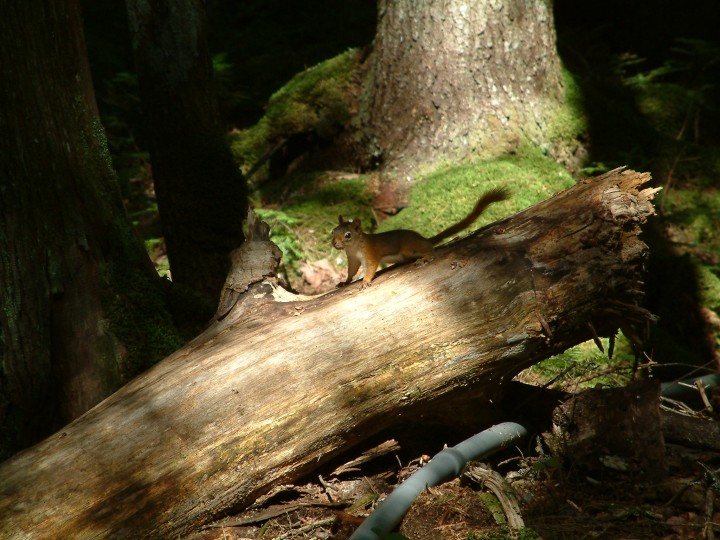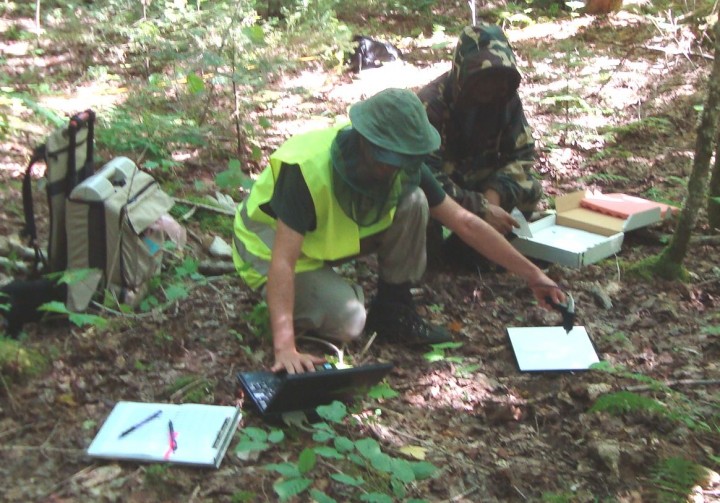Penobscot Experimental Forest, Baxter, ME
Temperature: 82 ° F Humidity: 68% Wind: 2 mph SW Sunny
From Dr. Ranson:
Something has been puzzling me the last few days. We’ve been out in these woods all day every day, but we’re just not seeing much wildlife. This is the wild North Woods, home to moose and bear – where are they? I’ve been looking and looking. I’ve seen some crows and gulls. I found a blue jay feather. There have been a few chipmunks and squirrels, mostly running away from us. But nothing else. What gives?
Today I was working as a recorder and wondering about the wildlife. It was hard to concentrate on my own thoughts, because my two measurers were constantly shouting numbers to me. I had to listen hard to separate their shouts from those of other measurers hollering to other recorders. Every once in awhile, the shouting would be interrupted by ringing laughter and people calling out to each other. Suddenly it dawned on me: tree measurement isn’t a quiet science. We’re just plain noisy. If I were an animal, I wouldn’t want to hang out near us, either. I guess I can give up my fantasy of seeing North Woods fauna, but I also guess we’re probably safe for stumbling across an unsuspecting bear. Noise does have it’s positive side.

We did see something interesting today – our first sugar maple. This used to be a very common species, but it’s becoming less so. That’s kind of sad. Besides being beautiful in the fall, the sap is harvested for syrup and sugar, so it’s a commercially important species. No one is entirely sure why the sugar maple is in decline. Most experts think the problem is s a result of the tree being stressed by environmental factors, leaving it open to attack by various diseases. There are reports from some places that saplings are less common, too. If the mature trees are dying without adequate replacement, then the species is certainly in trouble.
What strikes me most here is how changeable the forest is. Yesterday we worked in an area of big trees surround by very dense understory. You had to force your way through the smaller stuff. People only a few feet away seemed to disappear, it was so thick. We only had to actually measure the bigger trees, which were white pine, balsam fir, spruce and a few species of maples. But it took a lot of work to get to them.
Today we are only a few kilometers away from yesterday’s site. But the soil seems richer, the forest is a little damper and the species diversity is huge. There’s very large ash, some giant white pine, big spruce and some hemlock trees. We saw red maples and even a hop hornbeam, among other species. The understory was almost completely open, so it was easier to walk around. It’s hard to believe it’s the same forest! We’re seeing a huge change in forest even just a few subplots away. It’s really important to be on the ground and note this heterogeneity – we’ll have to pay attention to how the lidar interacts with all these different species.
We’re very interested in how lidar and radar interact with the forest in all sorts of ways. Besides the tree measurements, our modelers are now measuring reflectance of the forest floor and estimating the amount of leaf cover in the forest. Theoretical models must take these numbers into account, because they will affect the data we get from space.

The leaf area index is a number that represents how many leaves are on the trees. The sensing instruments will interact with few leaves and a thin canopy differently than if there are many leaves and a thick canopy. In areas with few leaves, more lidar will reach the earth and return, interacting with the leaves as it goes through it each way. So this is a really important number to get so we can better understand our data, our instruments and the influence of the leaves on the results.
We’re also measuring reflectance, which is the amount of light that reaches the forest floor. Lidar works by illuminating the surface of the earth and scattering back energy, then reading the energy returned. So if you have a forest floor that reflects a lot of energy back, you’ll get a very different reading than if you have a forest floor that absorbs energy. In order to understand the forest from our instruments, it’s essential to understand the floor, not just the height of the trees. We want to be able to separate the trees – the biomass – from all the extraneous readings.
The weather was a bit cooler and a less humid today. I like that and so do the mosquitoes! They are starting to show up now that it’s not so darn hot. They are not much problem if you are moving, but the folks who have to stand and hold clipboards all day tend to become bug attractants. They end up with clusters of bugs around them – and it’s hard to write that way. So some folks are wearing bug suits just to avoid the distraction. I don’t think it’s very bad. Compared to Siberia and my home near the Chesapeake Bay, this is pretty much a bug-free zone.




Hi Dr. Ranson, Most of the big wildlife in the remote parts of Maine are easily spooked by people sounds, smells, etc. It’s fairly common to spot deer and an occasional moose or black bear right around residential areas or along main highways in more populated areas of the state, where they have become desensitized to our presence.
Best of luck with your research here in Maine.
Hello Dr. Ranson,
While searching for another topic to read, I mistakly found your. Although, I may not be interested in the wildlife. Your discovery was somewhat interesting. I don’t ever see myself becoming that obsess with nature as you detailly explained in your article but I respect the fact that you found something you are pationate about and pursue it to the fullest.
High five to you
Sandrine Dadje’